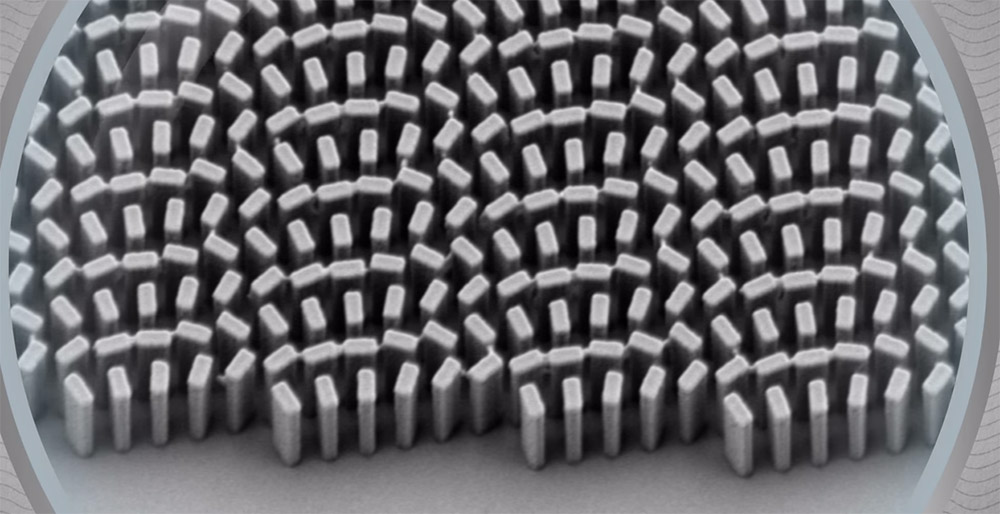Even though Oculus and HTC/Valve did a great job of slimming down the lenses used in the new generation of VR headsets, they're still one of the reasons the headsets are as big and as thick as they are. That could well change with the second generation though, as a new lens technology could usher in ultra-thin lenses for all sorts of industries.
For hundreds of years humans have been refining the process of grinding out lenses. The perfect, tapered shape has always eluded us, even in 2016, with solutions to make them thinner and more capable often resulting in annoying side effects and visual artefacts.
Close up shot of meta-lens' Titanium Dioxide ‘towers'
The new design, known as meta-material lenses, does away with all of that altogether and shrinks a lens down to the thickness of a human hair. These lenses are made up of thousands of microscopic ‘towers' of titanium dioxide, each capable of splitting and refocusing the light that hits them.
When arranged in a specific pattern, they can refocus all of the light on a single point, making them an effective lens. As effective, if not more so, than traditional lenses too, despite being far, far smaller.
For a better explanation, we'll let Science Magazine break down the real science of it: [yframe url='http://www.youtube.com/watch?v=ETx_fjM5pms']
Better yet, making this sort of meta-lens is incredibly easy. It might sound like a complicated process, but compared to the physical grinding and polishing of traditional lenses it's much easier. It's even compatible with fabrication plants currently producing silicon chips and other electronics, so mass production of these lenses could begin far quicker than you might have expected.
This could allow for not only much smaller VR headsets in the near future, but higher grade lenses for cameras, microscopes and telescopes, all in much, much smaller form factors than have ever been possible with traditional glass lenses.
Discuss on our Facebook page, HERE.
KitGuru Says: This may not seem it, but this is a huge breakthrough. After hundreds of years of refining traditional refracting lenses, scientists have still not made a perfect lens. Now they don't have to.
 KitGuru KitGuru.net – Tech News | Hardware News | Hardware Reviews | IOS | Mobile | Gaming | Graphics Cards
KitGuru KitGuru.net – Tech News | Hardware News | Hardware Reviews | IOS | Mobile | Gaming | Graphics Cards




Now we just need a wide FOV DLP based visualiser like in the avegant glyph. Gets rid of the screen door effect and allows far higher refresh.
That’s quite amazing but… I wonder… if it’s as thin as a human hair isn’t it also fragile, at the same amount? In the end it would need more glass on the front and backside of it to protect, just imagine when you accidentaly slap your camera lens with your fingers… Easy to clean but with a lens so thin as a human hair it would certainly break…
why would it, thin doesn’t mean weak, graphene has been shown to be so very strong a single layer of graphene one atom thick would have enough strength to hold about 5kg, so these metamaterials could be build with a thin atomic frame made from a stronger material. they could effectively be stronger than tradional lense.
Yeah, but they said already that it’s “titanium dioxide” not “graphene” also, if you want to know “why would it” try taking a handgun, and shooting a 0.3cm piece of aluminum, probably a 9mm can get through it easily, and I really mean EASILY then try a 10cm piece of the same aluminum and you will see that, it will probably just dent it. Yeah the thickness of a given material really makes a difference. Here’s a proof:
https://www.youtube.com/watch?v=8LpINxI73Vw
Prettymuch any material will eeeeasily break if it’s very thin, with Graphene beign the only exception to this rule untill now. I mean, accordingly to researchers spiders web are stronger than steel right?
This would be very good for eye glasses but they also need to make eye glasses that don’t scratch so damn easily and don’t get dirty so easily. My eyesight is too bad for contact lenses and I have been wearing glasses with 38 years.
“Prettymuch any material will eeeeasily break if it’s very thin”
Incorrect.
It’s all about the dimensional ratios and scaling.
The new TiO2 lenses would be much smaller in diameter (which is why they would be useful). This will also make them much harder to break. Regardless, the lens would need to be built in a frame, which will most likely be reinforced, making them even stronger. TiO2 lenses will no doubt be more durable than traditional lenses.
I don’t think this technology is relevant for image formation of polychromatic light.
I mean, if you look at the video, the “refractive effect” is made by diffraction of the nanopillars. And diffraction needs coherent light source to achieve interesting results (like a laser).
The image formed by this TiO2 lenses in the video are only from a green laser source if you look.
So… a full colored (full visible spectrum) object wouldn’t produce any image I’m afraid !
why not try projection just like google glass to make vr headset thinner?